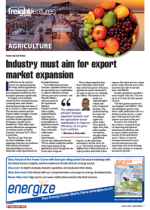Ag riculture is under pressure in the current challenging business environment. The sector contracted by 4.7% in 2023. According to the Bureau for Food and Agricultural Policy (BFAP), the sector has been plagued by climate issues, including drought, while crumbling road and water infrastructure, congestion at ports and the electricity crisis have further exacerbated the situation. These issues have been compounded by developments on the global stage, where surging inf lation, the cost of living crisis and ongoing geopolitical tensions have worsened the situation.“The sector has in recent years been faced with increasing volatility, and it is clear from the baseline projections that additional investment will be required to accelerate growth, boost productivity and bolster resilience to external shocks,” reads the BFAP’s latest outlook report.The organisation argues that now more than ever South Africa needs a stable and conducive policy and investment environment.Unless this is achieved, the agricultural sector will not be able to capitalise on potential upswings that are provided by markets and weather conditions.According to the BFAP with the government of national unity now in place, decisive action will be required by the new minister of agriculture, John Steenhuisen, to address the logistics, energy and water challenges faced by the agricultural sector.South Africa’s horticulture and livestock sectors in particular have been hammered by a combination of animal disease outbreaks, high feed costs, intense load-shedding, port congestion and weak consumer purchasing power. Field crop revenue, however, remained strong, bolstered by persistently high prices globally and strong yields.Despite the clear impact of these challenges, the 2024 BFAP Baseline sketches a picture of immense resilience. “The severe drought brought about by El Niño conditions in early 2024 and a 30% decline in global grain and oilseed prices saw real agricultural GDP projected to contract by only 2.2%, with losses in the field crop sector partly mitigated by higher revenue from horticulture. Agricultural trade performance remains strong, with its positive trade balance doubling over the past four years in US dollar terms. The livestock industry is also starting to gain some traction, as poultry production volumes are expected to recover from the worst avian inf luenza outbreak on record in 2023, and the outlook for beef is more positive following foot-and-mouth disease setbacks,” reads the report, which predicts agricultural GDP will expand by 3.5% in 2025 should rainfall in the country normalise.

